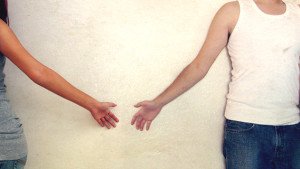Immigrating to the United Kingdom was a bold move. As a Latina, I had a lot to get used to, from cars driving on “the wrong side of the road” and the constant weather talk to the beautiful, fluffy texture of Yorkshire puddings. But one of the most shocking elements of my new culture was how seldom people hugged each other. During my first year, I visited a friend every week for “emergency hugs” until I had finally adjusted.
I fear that I adapted a little too well, though. I remember that on one of my first trips back home, I went to see a dentist for a routine check. When the friendly Argentinean dentist opened his office door, I stretched out my hand in British fashion. But instead of shaking my hand, he grabbed it, pulled me in and kissed me on the cheek. I was in complete shock for a few seconds. Then, I thought: “Relax, you’re home. This isn’t sexual harassment!”
Why would a dentist whom I’d never met before kiss me? Because an introductory kiss on the cheek is a sign of respect and affection in Argentina. In fact, not to kiss can be seen as arrogant and rude. While the amount and nature of touch is different from one culture to another, science has revealed that hugging and touching are essential to our wellbeing.
The most important sense
A baby can be born deaf or blind and still develop normally and enjoy a rich adult life. However, when babies are severely deprived of touch, as often happened in grossly understaffed orphanages in Romania during Ceausescu’s regime, the consequences are disastrous. Touch plays an indispensable role in early development. David Linden, professor of neuroscience at Johns Hopkins University (US), says that “growth is slowed, compulsive rocking and other self-soothing behaviours emerge, and, if not rectified, . . . disorders of mood, cognition and self-control can persist through adulthood.”
But touch isn’t good just for children or “touchy-feely” people. It’s fantastic for muscular NBA players too. A study found that when players touched more—celebrating scores with fist bumps, high-fives, head slaps, etc—they performed better. Why? Because touch fosters trust and cooperation.
Touch shapes the way we perceive and interact with people. Studies show that brushing fingers with a waiter will make you leave a larger tip. And something as seemingly innocuous as holding a hot drink can make you like people more. Our brains seem to equate the warmth from the cup with warmth of character. “Interpersonal touch is a crucial form of social glue,” says Professor Linden. “Pleasant touch activates the brain’s orbito-frontal cortex, which is responsible for feelings of compassion that help us to bond with people.”
High tech, high touch
As an expatriate, I really appreciate the opportunity to communicate with my family online. Technology has definitely made the world smaller and better connected. Paradoxically, it also seems to have dehumanised our daily lives, depleting them of human touch. We shop online or use the self-checkout machine at the supermarket. While we have hundreds of friends on social media, we can manage to go through an entire day without experiencing a single hug.
"Why would a dentist whom I’d never met before kiss me?"
But is technology to blame for touch deprivation, or can it come to the rescue? Haptics is a new field of study that aims at incorporating tactile sensations into our interaction with computers. In the future, computers will deliver vibrations and other tactile data—through dedicated globes, equipped with sensors—to create the illusion of virtual touch. This interactive touch technology could revolutionise online shopping—imagine being able to feel the fabric of a dress—and help train surgeons to master difficult procedures.
Will our computers hug us one day? Yes. In fact, “hugging technology” already exists! Huggy Pajama is a haptic jacket that allows parents to give a virtual hug to their children. The jacket has air pockets and heating patches to create the feeling of being hugged. It was developed by Mixed Reality Lab to help parents hug their children while they are on a business trip; but it may also help children with autism who are sensitive to human touch. It’s yet to be discovered whether virtual touch can create real intimacy and connection.
Your daily quota
My mum used to say that you need seven hugs a day to be healthy. I don’t believe there is, as yet, a scientifically recommended daily hug quota, but I hope we aren’t too far from the day when doctors will start prescribing hugs the way two serves of fruit and five of vegies are recommended!
Our skin is a fabulous organ—the largest in our body—and it’s covered with about five million sense receptors. There’s a good reason why it takes so much space and it’s so intricately designed: touch has a remarkable power. While we should always respect people’s boundaries, we lose as a society when we hold back too much and neglect our sense of touch.
Writing this article made me tune in to how much touch I have in my life and where I could add more. If you’d like to increase the benefits of touch in your life, here are a few suggestions: hug your friends and family often, get a massage regularly, high-five your teammates or pat a dog. To give your oxytocin level a super boost, try a 20-second hug with someone you love. Studies show that this will also develop your sense of mutual trust. There’s much to be gained from responsibly embracing our tactile sense!
". . . you need seven hugs a day to be healthy."
Finally, it’s thought-provoking to consider that while God created the physical world through His Word, He formed Adam and Eve with His hands! Similarly, when Jesus walked on Earth, He often used His hands to heal people, both physically and emotionally. Jesus touched lepers (Luke 5:12, 13), the untouchable people of His time. He allowed a prostitute to wash His feet (Luke 7:36–50). To heal a blind man, Jesus made mud—beautifully replicating the story of creation—and spread it over the man’s eyes (John 9:6).
God, the Creator of the sense of touch, sent a clear message of intimacy and connection through His touch of love.
Personal space
If you’ve ever ridden a crowded bus, you know that touch isn’t always enjoyable. When personal boundaries are crossed, touch can be unpleasant and even harmful. Recognising the power of touch doesn’t give us an excuse to invade the personal space of everyone around us. Touch nourishes us only in the context of mutual respect.
Safe touch, however, doesn’t have to mean no touch. Safe touch involves learning to set and respect our personal boundaries as well as those of others. Body boundaries are definitely not one-size-fits-all. They vary according to context, culture and personal preferences.
In practice, respecting boundaries could mean allowing your child to politely say, “No, thank you,” when someone wants to give him or her a tight hug. This can help him to learn he has the right to accept or refuse to be touched. Equally, it could mean allowing colleagues at work to greet each other with a hug if they want to. Recently, a friend told me that her office banned hugs as a “preventive measure” against sexual harassment. But avoiding all touch out of fear of being misunderstood or inviting sexual harassment lawsuits doesn’t solve the problem; in fact, it creates another. It means missing out on the power of touch to increase cooperation, trust and compassion. Fostering a culture of respect rather than fear is a far better approach!







